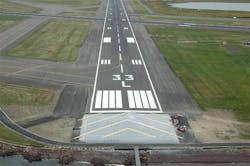U.S. airports may be reporting fewer runway and taxiway incursion incidents, but serious risks remain, a national transportation safety chairwoman said.
"These incidents remind us how vulnerable we are when procedures or people fail," said Deborah Hersman, chairwoman of the National Transportation Safety Board, referring to close calls at airports not in the air, but on the runways and taxiways.
The Federal Aviation Administration said there were 67 near collisions on the tarmac at airports classified as serious incidents in 2000 and only 12 in 2011.
The New York Times reported Tuesday that 35 major airports now have ground radar systems that allow control towers to tune in far more acutely to what is happening on the ground at airports where there can be as many as 100 flights taking off in an hour. At the same time, a large array of support vehicles carrying baggage, fuel and food are scurrying around the taxiways.
Contrary to assumptions, the airplane crash with the most fatalities in history did not occur in the air, but involved two planes that collided on a runway at Tenerife Airport in the Canary Islands in 1977.
That accident killed 583 people, the Times said.
In the last four years, near misses on runways occurred on average 1,000 times a year or three times per day with some of those incidents considered serious and others defined as less so.
Improvements were made after the Air Line Pilots Association warned in 2007 that the risks of an incident with hundreds of fatalities was "real and growing larger."
Among the latest developments is a system called Runway Status Lights, which automatically turns on red lights embedded in runways and taxiways when they are in use.
The Federal Aviation Administration is testing the system at Los Angeles International Airport and expects to install the system at 22 more airports by 2016.
Copyright 2012 U.P.I.All Rights Reserved


